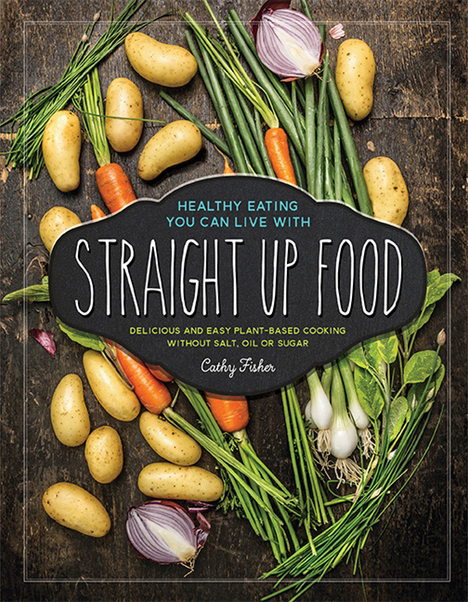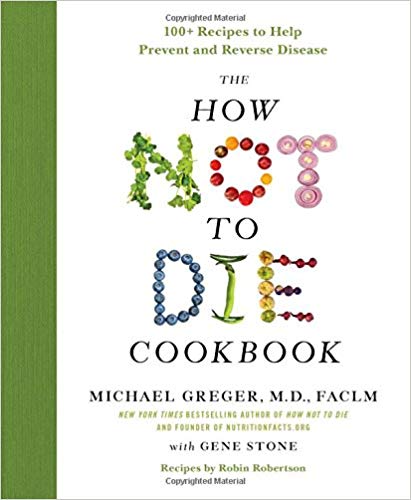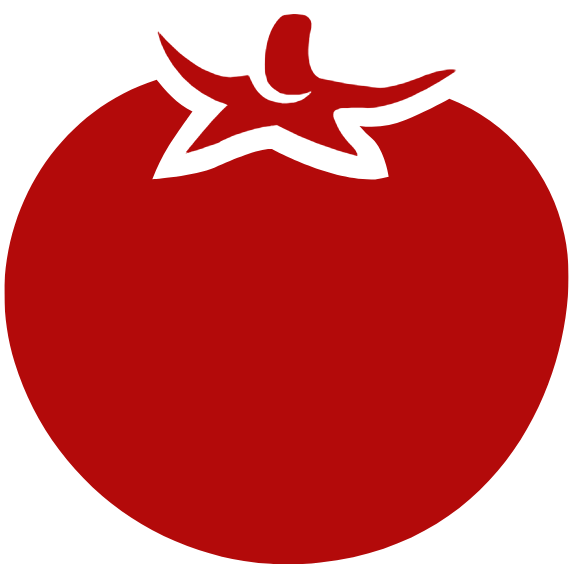What to Eat
A Guide
Eat All You Want: Nutrient Not Calorie Density
A Whole Foods Plant-Based (WFPB) lifestyle not only promotes optimum health and weight but is economical as well. In promoting optimum health, a WFPB lifestyle offers necessary nutrients contrary to much public misinformation. Also, major diseases of western society are mitigated and frequently reversed. WFPB diet interventions have been shown in studies to actually reverse heart disease and cancer, our two major causes of death. Not only is a WFPB lifestyle health-promoting, but it is also economical at individual, society, and planet levels.

What To Eat?
Dr. Michael Klaper, a noted plant-based physician, offers a memory cue he calls “The 4 S’s.” These are Soup, Salad, Steamed Vegetables, and Starches.1 These are whole and not “refined” foods.
Dr. Michael Greger, a widely published plant-based physician, summarizes ideal food with his Daily Dozen and number of servings and serving size:9
Beans, like pinto or lentils 3 (1/2 cup);
Berries, like blueberries 1 (1/2 cup);
Other Fruits, darker color the better 3 (1 cup);
Cruciferous Vegetables, like broccoli 1 (1/2 cup);
Greens, like kale or spinach 2;
Other Vegetables, 2 (1 cup leafy, ½ cup veggies);
Flaxseeds, (ground, 1 tbsp);
Nuts, ¼ cup;
Spices, (1/4 tsp Turmeric with pinch of black pepper);
Whole Grains, like brown rice and oatmeal 3 (1/2 cup);
Beverages, ideally water 5 (12 oz);
Exercise, like walking 90 minutes/day (start at 10 minutes and move up).
These fiber-rich foods feed your microbiome’s good bacteria and provide all the vitamins, minerals, fats, and complete protein, you need. The only supplement you will need is vitamin B12 in the amount of 2500 micrograms per week as methylcobalamin or cyanocobalamin because our present-day hygienic food no longer has this bacteria-produced vitamin.9
What To Avoid?
All meat (red meat, poultry & fish),7 dairy (especially cheese which is concentrated fat and salt), eggs, sweetened sodas, sugar and refined grain products like white bread and bagels. Avoid SOS: Salt, Oil, and Sugar. There is ample salt in plants so don’t cook with it as salt beyond a quarter teaspoon per day can cause high blood pressure that damages organs. If you need some put it only on the surface of food before you eat it.
A bowl of white sugar is highly processed from beets or cane leaving all nutrients behind and consists only of empty calories. Oil is a similar highly processed artificial product. An olive may be healthy, but olive oil is only fat at 9 calories per gram while protein and carbohydrates are 4 calories per gram. Sauté with water instead of oil.
Whole grain bread is healthy but finely ground flour products like white bread are not. This causes an insulin spike because of greater absorbability which can cause insulin resistance and eventually excess glucose in the blood causing diabetes. To be sure bread is truly whole grain make sure its carbohydrate to fiber ratio is 5:1 or less by reading Nutrition Facts on the package.9(375)
Alcoholic beverages are highly processed empty calories with few nutrients that should be avoided or only one small glass consumed per day.
What About Eating Out?
Restaurant chefs prepare food so that it tastes good and customers will return. The food is not healthy because it contains excess sugar, oil, salt, and fat. Eating in ethnic restaurants like Vietnamese, Indian, or Mexican where the food is prepared for you, and you specify no S.O.S can be a solution. You can also declare you are allergic to S.O.S and if you find nothing on the menu ask to speak to the chef and ask if he can prepare something. Frequently chefs will be happy to rise to the challenge. If eating at a friend’s home, ask to bring a dish. If going to a party bring a dish of chopped fruit.
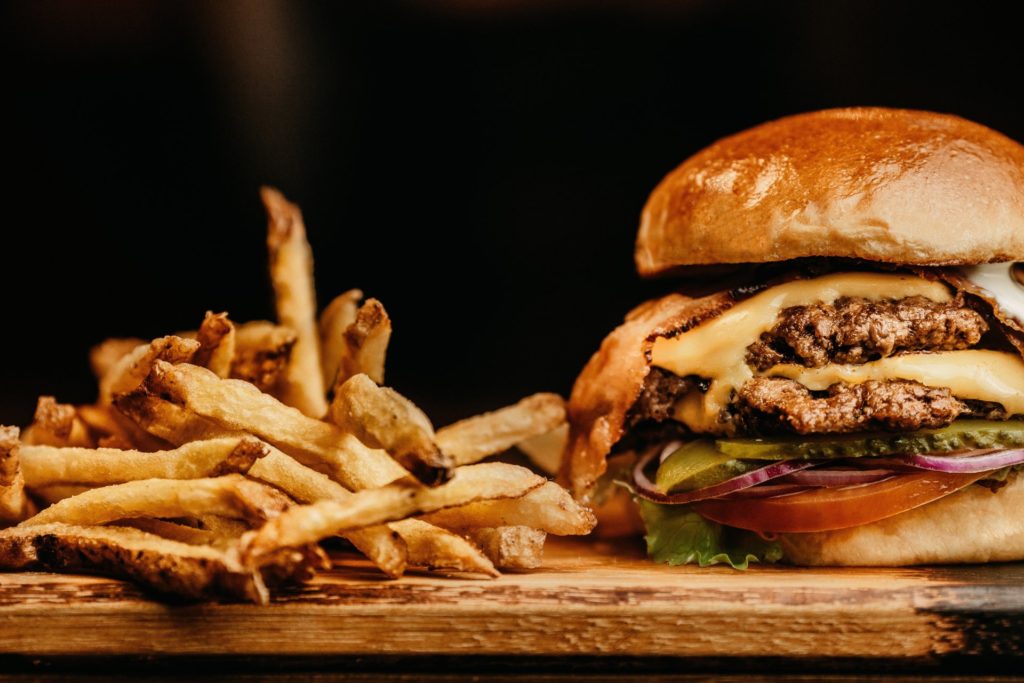
A Sample Eating Plan to Get All the Nutrients You Need.
The Physicians Committee for Responsible Medicine provides a diet plan for preventing obesity as well as not only preventing but reversing heart disease and Type 2 Diabetes:12
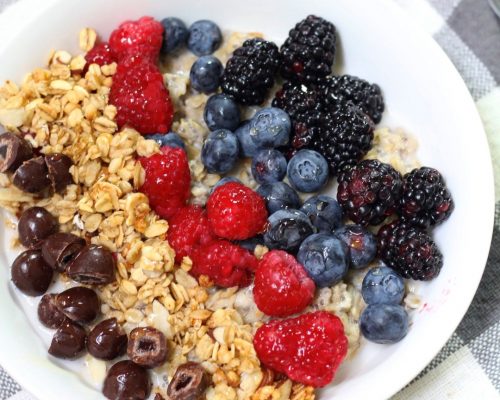
Breakfast
- Hot cereals: oatmeal with cinnamon, raisins, and/or applesauce
- All-Bran or muesli with nonfat soy or rice milk and/or berries, peach, or banana
- Fresh fruit
- Pumpernickel or rye toast topped with jam (no butter or margarine)
- Oven-roasted sweet potato home fries solo or smothered with sautéed mushrooms, peppers, and onions
- Tofu scramble.
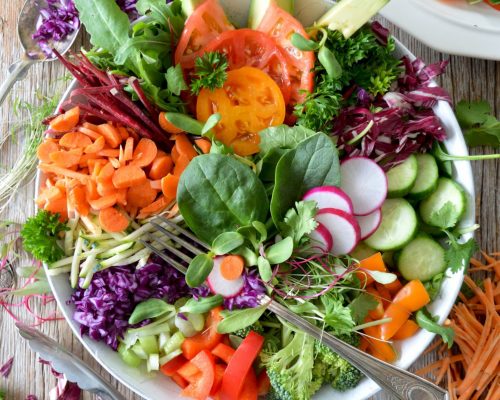
Lunch
- Mixed-vegetable salad with lemon juice, fat-free dressing, or soy or teriyaki sauce
- Legume-based salads: three-bean, chickpea, lentil, or black bean and corn salads
- Grain-based salads: noodle, couscous, bulgur, or rice salads
- Soups: carrot ginger, mixed vegetable, black bean, vegetarian chili, spinach lentil, minestrone, split pea, etc.
- Hummus spread on whole-wheat pita with grated carrots, sprouts, and cucumbers
- Black bean and sweet potato burrito with corn and tomatoes
- Sandwich made with fat-free meat alternatives such as barbecue seitan, Lightlife Smart Deli turkey style, or Yves veggie pepperoni slices and your favorite sandwich veggies.
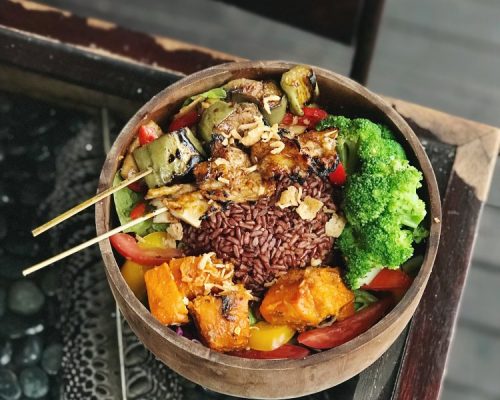
Dinner
- Pasta marinara: can be made with many commercial sauces (any brand that has less than 2 grams fat per serving and is free of animal products)
- Beans and rice: black beans with salsa, vegetarian baked beans, or fat-free refried beans
- Soft tacos: a flour tortilla filled with beans, lettuce, tomato, and salsa
- Fajitas: lightly sautéed sliced bell peppers, onion, and eggplant with fajita seasonings
- Chili: homemade or vegetarian boxed or canned versions
- Veggie lasagna: low-fat tofu replaces the ricotta cheese, layered with grilled veggies
- Vegetable stir-fry: vegetables seasoned with soy sauce or other low-fat stir-fry sauce and served over pasta, beans, or rice.
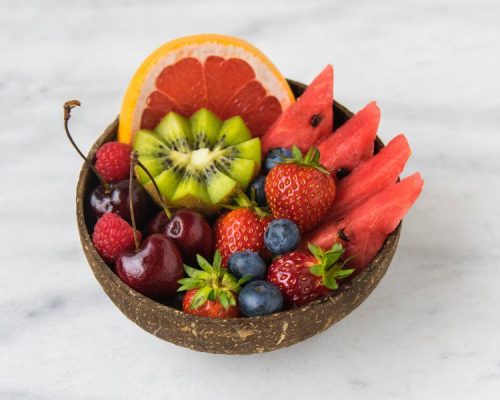
Snacks
- Fruit
- Carrot, celery, or other vegetables with low-fat hummus
- Baked tortilla chips with salsa or bean dip
- Air-popped popcorn or rice cakes
- Toast with jam
- Soup
Sources of Delicious Recipes
Myths About Food
There is a large number of conventional wisdom myths about food. Many have been handed down without people thinking about it from generation to generation. Others have been created by the food industry that spends billions promoting unhealthy products. Even the government has been complicit in promoting unhealthy food. The United States Department of Agriculture (USDA) has the dual and conflicting role of protecting consumers and also promoting the agriculture industry. Who has more political power, diverse individual consumers or large concentrated powerful food companies with massive advertising budgets? Government information programs like My Plate have been moving in the right direction by advocating consumers eat more fruit and vegetables, but they continue to promote unhealthy meat and dairy products. It is interesting to note that Canada’s version of My Plate as of 2019 replaced the cup of milk with water. What follows is an analysis of some of the major myths about food in the form of questions that are often asked by a misinformed member of the public.

Myth 1
Isn’t it unhealthy if you don’t eat meat?
There are pervasive myths that you must eat animal products like steak for protein and calcium from cow milk in order to ingest sufficient nutrients. Nothing could be further from the truth when you think about our gorilla cousins, elephants, and buffalo who are strong and healthy vegetarians.
What is even more important is that consuming animal products may be detrimental to health in many cases. There is sufficient protein in vegetables, and consuming meat may result in ingestion of excess protein that overworks the kidneys to their detriment.16 One thing a physician will often prescribe for kidney disease is to reduce meat consumption to reduce the burden on this blood filter.17
A myriad of diseases confronts those eating a Standard American Diet or SAD. The most prevalent cause of death is heart disease (cardiovascular disease or CVD), followed by others such as cancer, diabetes, and high blood pressure.18 There are different traditional medical treatments for each such as bypass surgery and stints for CVD, chemotherapy for cancer, and numerous drugs for diabetes and high blood pressure. However, A WFPB lifestyle treats them all at the causes of the affliction rather than the symptoms. For example, inserting a stint in a clogged artery may solve the CVD problem for a few years, but if the patient continues to eat the same SAD way after surgery the arteries may readily clog again. On the other hand, mitigating plaque buildup with a WFPB lifestyle solves the problem before it returns.
Numerous major studies support the position that a WFPB lifestyle reduces CVD risk.19 In the major Framingham study, no one who maintained a cholesterol level at or below150 mg/dL had a heart attack, and higher cholesterol is associated with animal product ingestion.20 While CVD is our number one killer there are large parts of the world where it is virtually non-existent, and a WFPB diet is consumed rather than the SAD. For example, in rural China, C. Colin Campbell found in the famous China Study that poor people who ate a diet of starch (mainly rice) and vegetables with little meat almost no heart disease was in evidence.21 Research in Uganda also showed almost no incidence of heart disease.22 Both of these groups ate different foods, but both were WFPB. Was this due to genetics? No, because immigration studies show that when people migrate from low CVD plant-based diet countries to high-risk countries like the U.S. and in Europe their CVD rates dramatically increase.23
More importantly, for those already suffering from CVD, a WFPB diet can actually reverse heart disease. The original breakthrough of this finding was made by Nathan Pritikin back in the 1970s.24 Pritikin was an engineer diagnosed with CVD who did his own thoroughly detailed research and found he could reverse his CVD. He subsequently founded a program and treated others with success. This research was followed by other pioneers such as Dean Ornish, M.D., Caldwell Esselstyn Jr., M.D., and John McDougall, M.D. who also were able to reverse CVD in their patients.25-28 These innovators made medical breakthroughs in contradiction to much of standard medical practice and conventional thinking that falsely believed diet had little to do with health.
The difficulty is that it is hard to overcome the foodways that one inherits from their parents. People may assume that their way of eating cannot be changed because they are used to it. They may act without thinking and are even addicted physiologically and psychologically to the salt, oil, and sugar-laden food they eat as is shown in Douglas Leslie and Alan Goldhamer’s insightful book, The Pleasure Trap.29
Myth 2
Where do you get your calcium if you don’t drink milk or eat cheese?
Attempting to obtain calcium via eating cow milk products can also be counter-productive. Cow milk evolved to grow a 60 lb. calf into a 2000 lb. cow in a relatively short time. In addition to excess hormones and antibiotics cows are fed that humans do not need, dairy products are acidic, and the human body is forced to remove calcium, which is a base, from the bones to neutralize acid.30 This process is just the opposite of the dairy industry marketing milk as a good source of calcium to strengthen bones when dairy actually weakens bones.
Generally, most nutrients are available in plants such as Protein, n-3 Fatty Acids, Iron, Zinc, Iodine, and Calcium.31 Also, plants provide numerous essential nutrients that animal products do not, such as Vitamin C and Fiber. Fiber is critical to moving nutrients to feed the bacteria in the colon, without which nutrients may be absorbed earlier, and good bacteria in the colon are deprived.32 There is a clear advantage of vegetable protein intake over animal protein intake in bone health. This is shown in a study of 33 countries where dairy consuming countries like the U.S. and Germany had significantly high rates of hip fractures (a major indicator of bone strength) while low dairy consuming countries like China and Japan had low rates.33 It is better to get your protein from plants.
Those on a WFPB lifestyle may be significantly healthier than those who are not. The only nutrient that is not readily available is B12, which is created by bacteria in the area of the anus. Man evolved in a dirtier environment in which B12 was supplied but is less available with today’s emphasis on cleanliness unless eating other animals. This one weakness in nutrient availability can be remedied through supplementation or food enrichment.34
Myth 3
How can you only eat one-quarter teaspoon of salt a day?
Salt, or sodium chloride, which provides 90% of sodium in the human diet,35 will be discussed interchangeably with sodium and has a fascinating history. Humankind has been historically confronted with starvation, and this was mitigated several thousand years ago with the discovery that salt could preserve food. An entire industry developed in Europe where salt was mined in Salzburg (salt city) and transported to Munich for marketing and distribution throughout Europe. Salt became so valued that Roman soldiers were paid in salt, from which comes the Roman word for salt “salarium” or “salary.” With the innovation of refrigeration a century ago, salt became largely irrelevant.
Most important now is determining the present effect on salt in the diet as it relates to health. Salt is unhealthy, not because some is needed, which it is, but because of the amount consumed in present-day society. Minute amounts appear in plants and meat that meet our requirements. The primary culprit in the unhealthy nature of salt consumed is that excess amounts are in processed and restaurant food, and unfortunately, society has significantly increased its intake of both. Not only has there been a dramatic rise in the fast-food industry, notably McDonald’s and Burger King, but a walk through your local supermarket shows that the produce section, where the real whole food resides, is a small part of the store. The rest of the store is dominated by processed food. Processed and restaurant food is convenient and sells well, but most of it has added salt, and some 70% of dietary sodium intake is from these sources outside the home.36 Moreover, 66-75% of human intake is added salt while only 14.2% is inherent to the food, only 5.6% is added in home food preparation, and 4.9% is added at the table.36 Therefore, the amount of excess salt consumed is a problem that has to be dealt with at the processed food and restaurant levels.
Excessive salt intake is associated with high blood pressure, which is a major risk factor for cardiovascular disease, the leading cause of death throughout the world.37 High blood pressure, or hypertension, is associated with 62% of strokes and 49% of coronary heart disease.38 Research shows that endothelial (critical inside lining of blood vessels) function is compromised from excess salt intake making blood vessels less flexible and mitigating nitric oxide production thereby increasing hypertension.39 To make matters worse, the results of adding a small amount of salt to your food translates to hypertension almost immediately. In a study, 6 grams of salt (about a teaspoon) was added to soup resulting in a 3.13 mmol/L salt in subjects’ blood.40 Since 1 mmol/L increase in plasma sodium is associated with 1.91 mm Hg increase in systolic blood pressure, this results in a blood pressure increase of almost 6 points. This is a significant increase considering that average systolic blood pressure is 120 mm Hg. In addition to CVD and stroke, renal disease, osteoporosis, stomach cancer, and asthma are also at increased risk due to excess salt.41,42
Since we know excessive salt is unhealthy, the questions remain as to what is excessive and what is the best level of salt intake? Excess salt intake is so important that the U.S. government has developed an entire food consumption program in a significant part built around a salt intake reduction called the DASH diet. DASH stands for Dietary Approaches to Stop Hypertension and is recommended by the USDA. The DASH-Sodium study recommended lowering intake of sodium to 2300 mg or lower and 1500 mg/day in adults with elevated blood pressure.43 The results of the DASH-Sodium study showed that a 1,500 mg/day sodium intake amount among hypertensive subjects resulted in average reductions of 11.5 systolic and 5.7 diastolic drops mm Hg, which is a major drop.44
While 2300 mg, about a teaspoon of salt, is recommended and 1500 mg is ideal, the average American consumes some 3,400 mg per day which is nearly 50 percent more than is recommended.45 How do we deal with this imbalance? First off, remove the salt shaker from the table. Next, cook without salt because salt flavor can be diluted and lost in cooking. If you must add salt, only sprinkle a small amount on the surface of the food before you eat it because your salt sensors are on the tip of your tongue. Most important, as pointed out above, restaurant and processed food is the source of 70% of your salt intake,36 avoid processed food, shop in the produce section, and cook your own food. When eating out, say you are allergic to salt. Season food with any of the vast selection of available spices. I season my popcorn with nutritional yeast, which has a terrific nutty flavor. What will happen in the long run is that your salt sensors in the brain will reduce the desire for salt and will become used to a new low-salt paradigm.29 A good general rule if you purchase processed food, like bread, is to check the Nutrition Facts label and see if the milligrams of sodium is less than the number of calories.9,129 The logic is that if you intake 2,200 calories in a day and salt is recommended at 2,300 mg, you will be under the upper limit of healthy salt intake. Enjoy an SOS (salt, oil, and sugar) excess free lifestyle.
Myth 4
Don’t you need to take vitamin supplements?
While in cases of vitamin deficiency or disease supplementation may be beneficial, routine dietary supplementation should be avoided for several reasons, which will be discussed. Instead, a Whole Food Plant-Based (WFPB) lifestyle consisting of food that provides ample nutrients is recommended here.
The first point against supplementation is that you don’t know what you are getting because supplements are not regulated like drugs, as they can be classified as food, which is exempt from rigorous nutrient inspection. As a result, potencies and added ingredients may not be as labeled.46
Another point is that there may be confusion and disagreement about the level of sufficiency. For example, vitamin D supplementation is widely recommended, and many physicians recommend vitamin D supplementation based upon the theory that serum hydroxyvitamin D <30 ng/mL is deficient. However, other research showed that hydroxyvitamin D <20 ng/mL was the true deficiency level,which is recommended by the Institute of Medicine (IOM).47 This is a significant difference in whether or not to recommend supplementation. A United Kingdom study set the level of deficiency at <10ng/mL.48. Also, many studies show that vitamin D supplementation has no preventive effect on bone health, even though vitamin D supplementation is widely prescribed.49
The third point is that supplements are not food. They are refined isolated manufactured products that may even be unhealthy. For example, a Cochrane review concluded that supplements like vitamins A and E could significantly increase mortality.50 An added point is that clients taking supplements may think that they do not have to be as concerned about eating quality food because they are getting their health from supplements when they are not.
Then there is the issue of supplements creating an out-of-balance situation among nutrients. Take one nutrient supplement like iron, and you may block the receptors from taking on other nutrients like zinc.51 Interestingly, this can happen with supplements but not when iron and zinc are eaten in plants in a meal.51
The only supplement I would recommend as a preventive measure for those with a WFPB diet is vitamin B12. B12 is created by bacteria involving feces and because modern-day food is sterile compared to the past, a supplement of B12 is good insurance to avoid deficiency.
Save your money and health by avoiding supplements and eating a WFPB diet.
This leaves the question of being able to obtain sufficient nutrients from a healthy diet, in particular, a WFPB one. Of course, it would take many books to cover this subject, and all that can be done here is summarize research and cite studies. In an RCT study (Random Controlled Trial, which is the research gold standard) overweight or obese subjects with T2 diabetes, ischemic heart disease, hypertension, or hypercholesterolemia showed significant improvement over the control group in BMI (Body Mass Index, or bodyweight) reduction and improvement in cholesterol and other risk factors through a WFPB diet.52 Then there is breakthrough research by Esselstyn53 and another by Ornish54 showing that heart disease, our number one killer, can be reversed by a WFPB lifestyle. The studies by these noted researchers and many others demonstrate the efficacy of a WFPB lifestyle. In particular, Kaiser Permanente recommends a WFPB lifestyle and a quote from their researchers and physicians summarizes their position nicely: “Healthy eating may be best achieved with a plant-based diet, which we define as a regimen that encourages whole, plant-based foods and discourages meats, dairy products, and eggs as well as all refined and processed foods.”55
The beauty of a WFPB diet is that you do not have to count calories or be concerned with intake volume because plant foods are nutrient-dense and not calorie-dense like processed foods in the Standard American Diet (SAD). For example, a medium-sized potato has 160 calories, with many phytonutrients like fiber, vitamin C, potassium, and vitamin B-6, and you will feel full because one potato will almost fill your stomach.56 Eat a tablespoon of butter or oil which has 100 calories56 and that will be a very small amount in your stomach, making you hungry. Same with cheese, which has 113 calories in a single slice.56 You will feel full with a nutritious meal of potato, beans, and a few veggies. However, cheese and butter and other calorie-dense processed foods in SAD provide unhealthy fat, and unless you eat hundreds of extra calories, making you overweight, which is associated with ill health you will feel starved.12 As the research above shows, a diet of greens, grains, and fruit provides necessary nutrients and can reverse our most serious illnesses.
Support for a WFPB diet has been even more refined by three 2019 studies that compare healthier plant foods with less healthy plant foods and animal foods.11 Healthy plant foods were defined as emphasizing whole grains, fruits, vegetables, nuts, and legumes. Less healthy was defined as emphasizing refined grains, potato/fries, sweets, and juices. Healthy plant foods resulted in significantly lower weight gain, while less healthy plant food and animal foods resulted in higher weight gains. The findings support the recommendation to increase intake of healthy plant foods and reduce intake of less healthy refined food and animal food.58
In summary, it is best to obtain your nutrients from whole grains, fruit, and vegetables and avoid processed supplements, with the exception of vitamin B12, for health promotion and disease prevention.
Myth 5
Isn’t eating fast food cheap and eating fruit and vegetables expensive?
Let us look at what a subsistence WFPB lifestyle would cost shopping at Walmart.59 Walmart sells a 20 lb. bag of rice for $10.58 which, at ½ cup dry for a 1 cup serving the cost can be rounded up to 14 cents per serving. Walmart sells dry Pinto beans for $8.98 for 8 lbs., so a half cup dry for a 1 cup serving costs 28 cents. Walmart sells frozen broccoli at $1.44 for 14 oz. so a quarter cup could cost would cost 41 cents. Spinach costs $2.38 for a 10 oz. bag so add perhaps 2 oz. for 48 cents. Add these together and the result is $1.31 for a lunch or dinner. Quaker Oats for breakfast costs $4 for 42 oz. or ½ cup dry at 38 cents per serving. Add 42 cents for breakfast, $1.31 for lunch and again for dinner and the total comes to $3.04 per day. Compare $3.04 per day with the government Supplemental Nutritional Assistance Program, or SNAP at $154 per month per individual, or $5.13 per day and one can actually live on SNAP with money left over for condiments, fruit, and other items. This goes to show that people who qualify for SNAP can actually live cheaply on a budget designed by the government to be only supplemental, if that budget is based on a WFPB diet. However, if you add meat, dairy and eggs to the diet you would find it extremely difficult to prepare a single meal for this $3-$5 daily cost.
In addition, a subsistence diet can be enhanced economically through improved information about what healthy foods to buy that are economical. In particular, cruciferous vegetables like broccoli, cauliflower, and red cabbage, at one dollar per pound, are inexpensive and are extremely high in antioxidants. Another approach that anyone can do to grow and harvest vegetables in their own kitchens is sprouting. A few dollars’ worth of seeds like broccoli seeds can be sprouted in three days providing fresh salad ingredients for many meals. These vegetables strengthen the immune system that mitigates sickness which is even more economical as an individual’s health care costs are reduced.
Not only does a WFPB lifestyle contribute to less illness, which lowers health care costs for the individual, but it is also a benefit to society as it reduces the costs of many externalities. Animal production and its waste products that pollute rivers and increase the costs of oil usage are just some of the external costs that must be borne by society as a whole. A 2015 University of Oxford study projects that if society continues to consume meat at the present rate rather than adopting a WFPB diet the cost could be up to $289 billion annually and globally up to $1.6 trillion by 2050.21 They project that if Americans ate vegan, Direct Health Care Savings would be $208 billion in the U.S. and $684 billion worldwide. Indirect Health Care Savings would be $40.5 billion and $382 billion worldwide. Environmental savings would be $40 billion U.S. and $569 worldwide.60 Environmental costs could be even greater if climate change projections prove to be valid.

